Are Dry Rotted Tires Safe
This post contains affiliate links. As an Amazon Associate, we earn from qualifying purchases.
Driving on dry rotted tires is extremely dangerous and should be avoided due to the high risk of sudden blowouts and accidents, especially at high speeds or with heavy loads. These tires have a weakened structure, often with visible cracks on the sidewalls, which reduces traction on wet roads and increases stopping distances. For more detailed insights on the hazards, prevention tips, and replacement guidelines, continue reading the full article.
Essential Facts in 30 Seconds
- Dry rotted tires are unsafe due to a higher risk of blowouts from weakened rubber.
- Cracks in sidewalls decrease traction, increasing skidding risks on wet roads.
- Damaged tires lead to longer stopping distances, creating emergency hazards.
- Tires with deep cracks or hardened rubber must be replaced immediately for safety.
- Regular inspections are essential to detect dry rot early and avoid dangerous driving conditions.
Understanding Dry Rot in Tires
Tires face tough conditions, yet dry rot can sneak up on you. This problem comes from rubber breaking down over time. Sunlight and ozone make it worse, fast. Extreme heat above 68°F or cold below 45°F damages tires too. Quick weather changes also hurt the rubber badly. Additionally, improper storage in damp or unventilated areas can accelerate tire deterioration.
Take care of your tires to stay safe on the road. Drive often to keep the rubber soft and strong. Check tire pressure to avoid sidewall stress. Move stored cars now and then to spread pressure evenly. Regular inspections can help spot early dry rot signs before they worsen.
Think about these key points for tire health:
- Age: Old tires rot quicker than new ones.
- Storage: Keep tires indoors, away from sun.
- Protection: Use special sprays to block UV rays.
Identifying Symptoms of Dry Rot
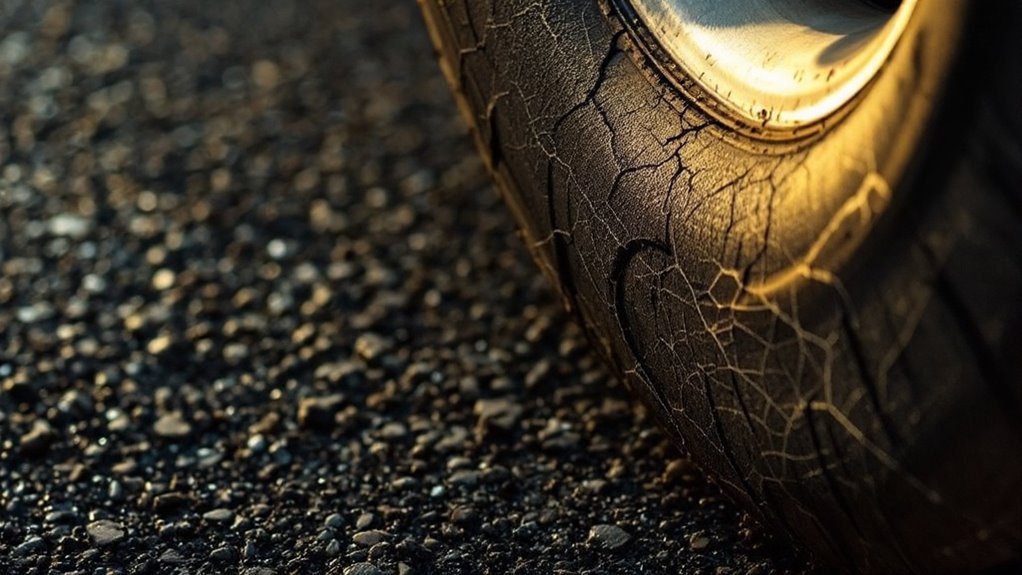
Spotting dry rot in your vehicle’s tires keeps you safe on the road. Dry rot can cause big problems if ignored. Check your tires often to catch early signs. You might see tiny cracks on the tire sidewalls. These cracks look like old, worn-out leather. The rubber may also turn gray from sun damage.
Touch the tire. Does it feel hard or break easily? That’s a bad sign of dry rot. Over time, exposure to sunlight can worsen the damage to tire rubber. Regular inspections can help identify early dry rot signs before they become severe hazards.
Here are clear signs to look for:
- Sidewall Cracks: See small lines or big splits on the edges.
- Color Change: Notice gray patches instead of deep black rubber.
- Hard Texture: Push the sidewall. It feels stiff or crumbles fast.
- Air Leaks: Watch for slow air loss from tiny cracks.
Stay alert and check tires regularly. Your safety depends on it!
Safety Hazards of Driving on Dry Rotted Tires
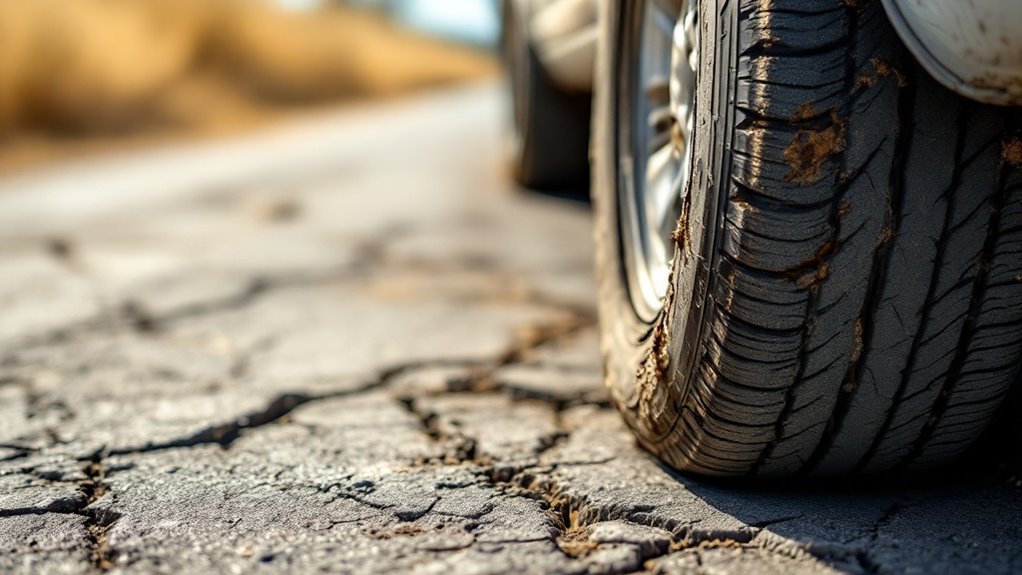
Driving on dry rotted tires puts you in serious danger.
Tiny cracks form on the sidewalls and tread. These cracks grow bigger over time from sun damage. They weaken the tire and raise blowout risks. At high speeds, a blowout can mean losing control. Data shows 11% of crashes link to tire failure.
Dry rot also cuts down traction on roads. Wet roads become extra slippery with these tires. Sharp turns or quick stops often lead to skids. This significantly increases stopping distances during emergencies. Even small cracks can deepen unnoticed, posing hidden severe risks.
Stay safe and check tires for cracks regularly.
Tire Structural Weakness
Check your car tires often for signs of damage. Dry rot can weaken them over time. Aging rubber loses strength from heat, sun, and wet weather. Cracks and splits show up on the tire sides. This makes tires unsafe for driving.
Look out for these danger signs:
- Sidewall cracks – See splits that mean inside damage.
- Faded color – Gray or dull tires lose protective oils.
- Hard texture – Tires feel stiff and not bendy.
- Tiny splits – Small cracks on treads signal wear.
Act fast if you spot these issues. Weak tires risk your safety on every trip.
Keep your vehicle stable by checking tires regularly. Don’t wait for a problem to grow big. Stay safe on the road today! Regular inspections can help identify early dry rot before it becomes a major hazard.
Risk of Blowouts
Pay attention to weak spots in old, dry tires. Cracks on sidewalls spell big trouble. Hardened rubber from sun and heat raises blowout risks. A sudden air loss at high speed? That’s a disaster waiting. Data shows tires over six years often fail fast.
Take action to stop blowouts before they strike. Check tires often for cracks or stiffness. Look closely at sidewalls for tiny breaks. Even small damage can explode on wet roads. Spot these issues early:
- Cracks you can see on sides
- Rubber that won’t bend
- Odd bulges or bubbles
Swap out bad tires right away. Patches don’t cut it for safety. Ignore this, and you risk wild swerving. Stay safe with quick checks! Regular inspections can prevent severe dry rot from escalating into dangerous tire failure.
Handling and Braking Issues
Dry rotted tires create big risks for your car’s handling and braking. They make driving unsafe. Cracked sidewalls and brittle treads mess up your control. Cornering feels shaky. Swerving can be dangerous. Braking takes longer too. You might lose control on wet roads or bumpy paths.
Think about these key problems:
- Air Leaks: Tires lose air slowly, making steering hard.
- Weak Sidewalls: They don’t handle bumps, so steering suffers.
- Worn Treads: Tiny cracks cut grip, raising slip risks.
- Tire Breaks: They can snap under weight, risking crashes.
Stay safe out there. Check your tires often. Don’t wait for a disaster. A quick look can save you. Additionally, neglecting regular inspections can lead to issues like tire cupping, which further compromises safety and handling.
Studies show 1 in 5 crashes link to bad tires. Act now to avoid trouble.
When to Replace Tires With Dry Rot
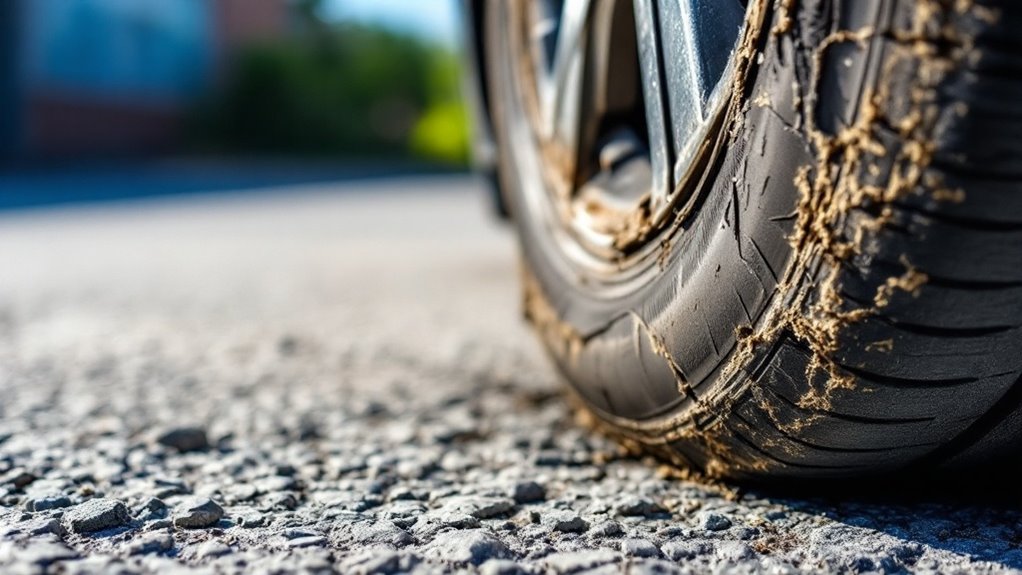
Tires with dry rot are a big danger. Check them often for safety. You might see cracks on the side or top. These cracks mean the tire is weak. A weak tire can burst while driving. Even tiny cracks grow bigger fast. Don’t wait to fix this problem.
Look for these signs to know if replacement is needed:
- Deep cracks on the side or top.
- Rubber feels hard and breaks easily.
- Tires lose air or go flat.
Replace tires right away if cracks are deep. Don’t drive on bad tires even for a day. Experts say failure happens in just months. Act fast to stay safe.
Keep control of your car on the road. Data shows blowouts cause many accidents yearly. Protect yourself now. Regular tire inspections can help identify dry rot issues before they become hazardous.
Tips for Preventing Tire Dry Rot
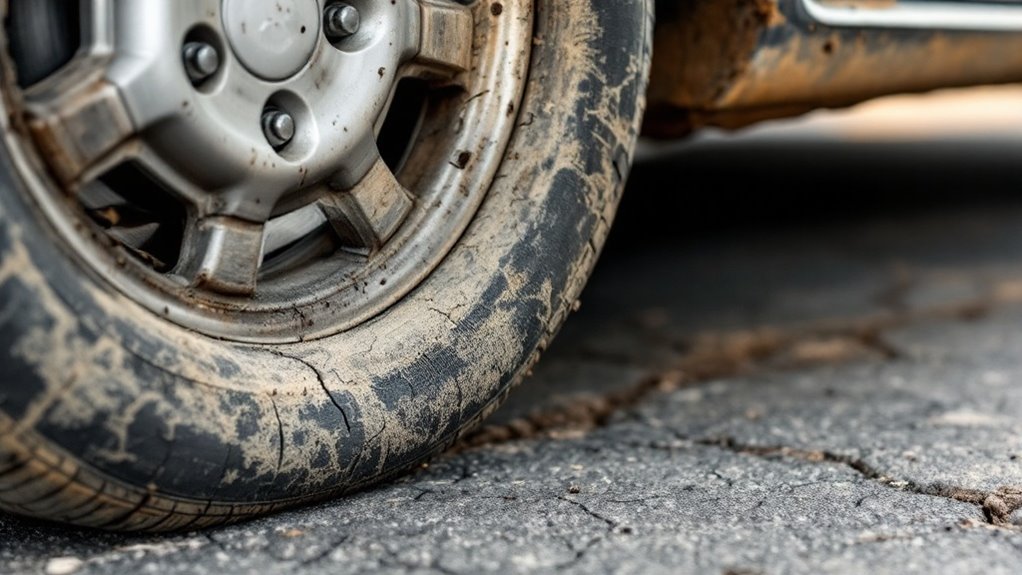
Tires with dry rot can be dangerous. Stopping this problem early saves money and keeps you safe. Good tire care makes tires last longer. It also stops risky situations on the road.
Storage matters a lot for keeping tires strong. Especially if your car sits unused for long.
Check out these easy tips to stop dry rot:
- Block Sunlight: Keep tires inside or use covers. Sun damages rubber fast.
- Check Air Pressure: Look at tire pressure every month. Fill to the right level.
- Clean Often: Use mild soap to wash tires. Skip harsh chemical cleaners.
- Store Smart: Put tires in a cool, dry place. Use pallets to lift them up.
Regular inspections can help detect early cracks and prevent further tire deterioration.
Guidelines for Tire Safety and Replacement
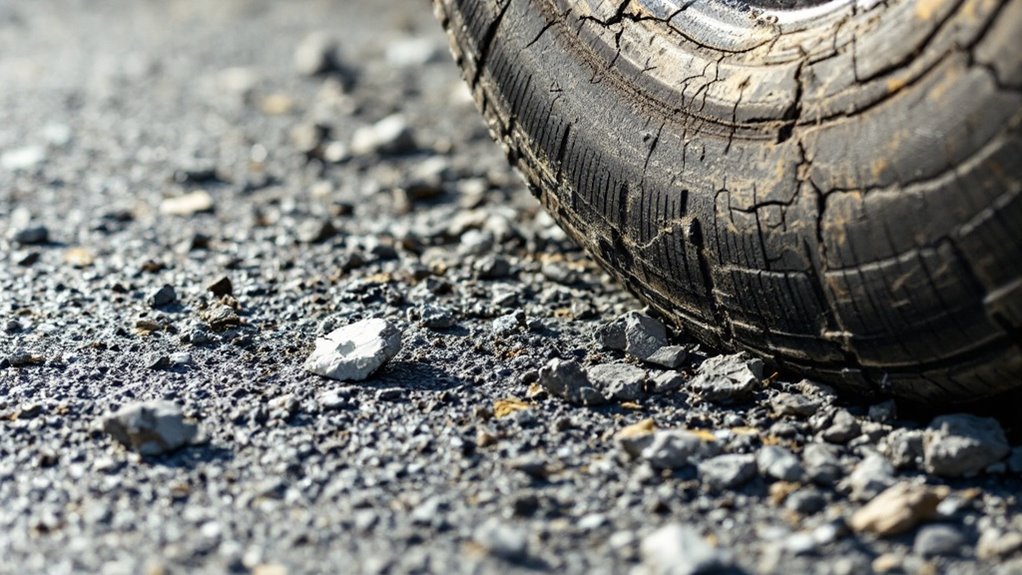
Tires need regular checks to stay safe on the road. Look at the sidewalls for cracks or dry rot. Sunlight can harm tires if they sit outside too long.
Measure tread depth with a simple gauge. Replace tires if depth is below 2/32 inch. Age matters too—tires over 6 years might need a swap. Check air pressure every month with a good tool. Proper air keeps driving smooth and safe. Always inspect the DOT code on tires to determine their manufacturing date and assess age-related risks.
Spot these signs for quick action or care:
- Tread Depth: Under 2/32 inch? Change them now.
- Sidewall Damage: See cracks or rot? Replace right away.
- Tire Age: Past 6 years? Think about new ones.
Assessing Dry Rot Risks
Are your tires safe, or do they’ve dry rot?
Dry rot makes tires weak and risky. Sunlight and bad care often cause this problem. Cracks on sidewalls or tread can lead to blowouts. Even small cracks put you in danger on the road.
Check your tires for these clear signs of trouble:
- Cracks You See: Spot splits on sidewalls or tread. They show big damage.
- Faded Color: See gray or dull rubber? It means the tire is breaking down.
- Hard Rubber: Touch the tire. Does it feel stiff? That’s a bad sign.
- Strange Wear: Notice uneven spots on the tire? Dry rot might be the cause.
- Regular inspections can help identify dry rot signs before they become a serious threat.
Timing Tire Replacement
Tires need replacement to keep you safe on the road. Spot dry rot signs early. Tire lifespan is often under 10 years due to wear. Check tread depth often. Replace tires at 2/32 of an inch for good grip. Look at sidewalls for bulges or steel belts. These mean replace now.
Age can harm tires even without clear damage. Wrong air pressure or holes also cut life short. Stick to these tips:
- Swap tires if tread wears out or damage shows.
- Never keep tires over 10 years, no matter what.
- Check every month for odd signs or issues.
Stay alert. Safe tires save lives. Data says worn tires cause many crashes. Keep checking yours. Simple steps make big differences.
Ensuring Safe Driving
Why care about tire safety for safe driving? Tires connect your car to the road. Bad tires mean less control, especially in rain or ice. Ignoring them risks blowouts or skids, causing crashes.
Let’s keep you safe with easy driving tips. Check these out!
- Test tire pressure every month. Use a gauge on cold tires. Follow the car maker’s guide.
- Look at tread depth often. Change tires at 2/32 inch. This stops slipping on water.
- Fix wheel alignment after potholes. It helps tires wear evenly.
- Drive slower in wet weather. This keeps your grip strong.
Frequently Asked Questions
Can Dry Rotted Tires Be Recycled Safely?
Dry rotted tires? No problem, you can recycle them safely! Tire recycling helps manage waste the right way. Take them to special centers for eco-friendly disposal. These places process tires without hurting the environment. Your health stays safe too. Did you know? Over 290 million tires get recycled yearly in the U.S.! That’s a huge win for our planet. Stick to simple steps. Drop off tires at local recycling spots. Let’s keep our world clean together!
Do Certain Tire Brands Resist Dry Rot Better?
Are some tire brands better at fighting dry rot? Let’s find out together! Many experts say Michelin and Goodyear stand out. Why? Their tires use strong materials that last longer. Dry rot happens from heat and no use. These brands resist cracks and damage well. Studies show Michelin tires often last over 5 years. Goodyear also gets high marks for durability. Pick a trusted brand for safer drives. Keep tires clean and store them right too!
How Does Altitude Affect Tire Dry Rot?
Ever wonder how high places mess with your tires? Altitude makes rubber dry out super fast. This speeds up tire dry rot big time. Check your tires a lot for cracks. Keep them safe from the sun’s harmful rays. Studies show high elevations cut tire life by 20%. Act now to save your tires!
Are There Legal Penalties for Using Dry Rotted Tires?
Got questions about legal penalties for dry rotted tires? Let’s dive right in. Tire safety matters a lot. Bad tires can get you in trouble. Many places give tickets for unsafe tires. Some states fail your car inspection too. Dry rot makes tires weak and risky. Cops can fine you for this issue. Always check tires for cracks or damage. Stay safe and avoid legal hassles. Replace bad tires before problems start. Keep your ride legal and secure.
Can Tire Dry Rot Spread to Other Tires?
Got questions about tire dry rot spreading? Let’s clear it up fast. Tire dry rot doesn’t jump from one tire to another. Rubber damage isn’t like a cold. It won’t spread on its own. Each tire faces its own wear and tear. Studies show dry rot comes from age or bad care. Think sunlight, heat, or no cleaning. Protect each tire with regular checks. Store them in cool, shady spots. Use tire cleaners to keep them fresh. Don’t stress about rot spreading. Focus on good maintenance for safety. Your tires will thank you!
Conclusion
Tires with dry rot are a big danger. Every year, 11,000 crashes happen in the U.S. because of bad tires. Dry rot often causes these accidents. Don’t take a chance with your safety. Replace those damaged tires right away. Check your tires often for cracks or wear. Store them properly to avoid problems. Stay alert and keep your journeys safe. Protect yourself and others on the road. Act fast to stop tragic crashes.
